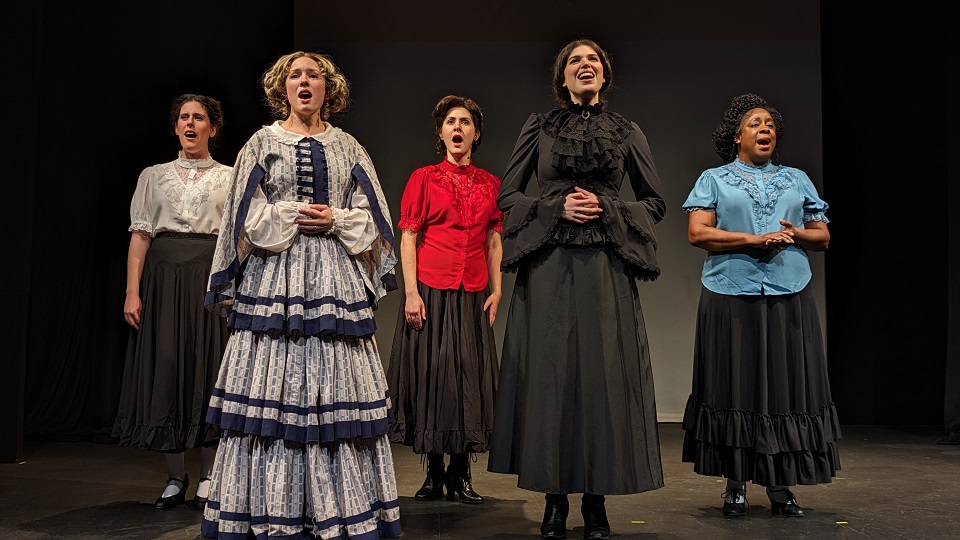
SIERRA MADRE, Calif. — Nestled into this small city of 12,000, a suburb of Pasadena in Los Angeles County is the storied Sierra Madre Playhouse, a minor jewel in the diadem of Southern California’s regional theater scene. A company that ranks a step or two above the pejorative-sounding term “community theater,” it often presents challenging work on difficult, controversial themes and owns a proud history of world premieres.
The theater’s latest venture is a world premiere engagement of The Right is Ours!, a new musical about two women who were founders of the women’s suffrage movement, beginning with the famous gathering at Seneca Falls, N.Y., in 1848 that launched the demand for women’s rights and especially for votes for women. Elizabeth Cady Stanton (1815-1902) was the godmother of the movement, passionate with her writings and speeches, and the 1895 author of the theologically radical The Woman’s Bible. She met Susan B. Anthony (1820-1906)—who had not attend the Seneca Falls Convention—in 1851, and each found in the other a steady intellectual companion and comrade.
Their relationship, close as it was, retained a somewhat formal character. The elder woman, wife of the prominent lawyer and abolitionist Henry Brewster Stanton, asked to be called “Mrs. Stanton,” and she, in turn, addressed her friend and acolyte as “Susan.” It was Stanton who came up with the slogan “The Right is Ours!” Responsible for her nursery full of children, Stanton preferred to stay home and pen stirring statements which the more mobile Anthony would habitually deliver on the lecture circuit, often omitting her mentor’s paeans to sacred motherhood.
Through the decades-long relationship between these two feminist powerhouses, book writer Lloyd J. Schwartz, collaborating with Adryan Russ on music and lyrics, touch on the debates swirling around the suffrage movement, some of its early successes and disappointments, and the turbulent 19th-century characterized by the Civil War and women’s increasing roles in society despite burdensome limitations on their advancement.

Focused as this relatively privileged class of women were on achieving the vote and reform of reproductive laws, marriage and divorce laws, and professional recognition, the concerns of women as workers, both at home and in factories, were notably downplayed. It took the labor movement, and many of the various factions among reformers and socialists, further long decades to understand that oppression and attacks on women (and today’s LGBTQI folk) were part of the overall social and economic domination by Capital itself.
Among the most contentious issues in the women’s movement at that early time were the Civil War (was it truly necessary to fight? asks the pacifist Quaker Anthony), as well as the post-Civil War Constitutional right given to Black men to vote. Some suffragists actually opposed granting Black men the right to vote so long as the vote for women was still denied. Other women could see that advances would inevitably come, however unevenly, unfairly and belatedly, and continued pressing their demands to be met a later day. Frederick Douglass, for one, weighed in on the greater urgency of the Black struggle, as compared to women’s oppression.
Both of the women featured in The Right is Ours! had been active in the temperance movement, itself a form of feminism not so much from a moralistic point of view, but largely because men’s paltry wages, needed to support a wife and family, were often squandered on cheap and widely available drink. It’s not surprising that the 18th Amendment, prohibiting the “manufacture, sale, or transportation of intoxicating liquors,” was finally ratified by the states on January 16, 1919, an achievement, it could be argued, of the women’s movement, even though it would later be repealed as unenforceable. The 19th Amendment, ratifying the vote for women, passed the very next year.

The two issues are connected at the hip. Although several states, such as Kansas, Wyoming and Utah—the latter a heavily Mormon population—first allowed women to vote, in 1894 Californians voted against it, fearing that if women got the vote they’d ban alcohol, which was clearly more important. In fact, Stanton had once observed that the men of the Boston Tea Party threw tea into the harbor—women’s preferred drink—not whisky, which was also subject to high taxation.
The Right Is Ours! opened on Sept. 8, and I caught up with it the following weekend, on the 16th. It centers Anna Mintzer as Anthony, Emily Abeles as Mrs. Stanton, and a three-woman all-purpose chorus of Ida (Paige Berkovitz), Christabel (Carlin Castellano), and Emmeline (Jacquelin Lorraine Schofield), with understudies alternating as needed. In this all-woman cast, each of these versatile three, a kind of Greek chorus without the gravitas, plays picketers, household servants, women who want to play golf or ride bicycles wearing the new “bloomers” for comfort, printers putting out copies of the suffragists’ newspaper The Revolution, babies in their playpen or children falling asleep to bedtime stories. Each wears a black skirt (most of the time), and a blouse of white, blue or red to show their patriotism.
Schwartz, author of some 43 produced plays and a frequent presence at this theater, directs the musical and has also written the book of the show. Adryan Russ is the composer and lyricist. Choreography is by Kay Cole, and costumes are by Vicki Conrad. Gregory Crafts designed the set as well as the lighting, with projections by Rick Simone.
Running 90 minutes without intermission, the musical dutifully checks off most of its points on the timeline from 1848 to the beginning of the 20th century. Its 20 songs (three of them reprises) establish the premise of the right to vote, the restrictiveness of the law and of the costumes women were expected to don, the limited role of women as mothers, homemakers and companions to husbands, as well as, for some, the need to establish our own families—a theme underscored by Susan B. Anthony, who never married or had children in her “single blessedness.” For all of them, foreshadowing the future Betty Friedan and the discontent of the mid-20th-century woman, “there is more to life than this.” The single standout song, for theme, originality and vocal prowess is “Ain’t I a Woman,” sung by the one Black woman in the chorus (Ms. Schofield), as a stirring tribute to Sojourner Truth.
For the most part, the dialogue is utilitarian, as the discussion ensues over such issues as race, women’s roles as helpmates and mothers, compromise over principle and immediate or gradualist demands. The lyrics are prompted by documents such as the “Declaration of Sentiments” issued at Seneca Falls, recalling such patriotic cantatas as Randall Thompson’s Testament of Freedom, based on the writings of Thomas Jefferson and embraced in the 1980s by the emerging gay and lesbian choral movement. Verses and rhymes switch between treacly and forced when not merely slogans set to a tune: Seneca Falls, for example, is “a place where history recalls”; and “despite the rumors, I love my bloomers.” “At last we wear the pants,” the chorus sings all too predictably.

Sing, sing, with one voice sing.
Let freedom ring.
Sing with one voice,
Make your own choice.
We will carry on!
The musical has a noble, important theme. The principal creators—book and lyrics—have consistently opted for the obvious rhyme, the simple message, the surface characterization. Its target audience would seem to be high school or even junior high classes. Subtlety is on short supply. And, significantly for the times we live in right now, while Stanton and Anthony are contrasted as family- and single-oriented, this is not quite the whole picture. Anthony believed in the very modern notion of “creating our own families” because she was in fact a lesbian who had a succession of relationships with other women. This is only hinted at in the musical: toward the end, as the widow Stanton is entering her last year or two of life, when Anthony proposes their living together; when Anthony is seen walking off the rear stage hand-in-hand with one of the choristers; when she sings, “There is love that cannot be denied.” With the LGBTQI community now under severe attack, it would seem high time, whether to school-age or Broadway theatergoers, to acknowledge Anthony, a celebrated figure of our national history, as a queer woman.

The music direction is by Gregory Nabours, with orchestrations by Kat Sherrell. Audiences will not see them, however. From all appearances, it seems the score was pre-recorded, and I believe it’s safe to say on electronic instruments, while the stage actors sing along to it. I don’t know if the term “karaoke musical” has entered the language quite yet but it applies here. It certainly keeps production costs down, but also yields up a tinny, artificial soundscape.
The Right Is Ours! celebrates the inspiring story of brave, countercultural women who changed the world to give women a greater voice in their lives. “We’ll never be equal until we get the vote,” the suffragists declaim, insensitive to the multiplicity of other ways a society can institute inequality. Though the lyricist does include a line for Anthony, arrested for trying to cast a vote, saying, “Robbing citizens of their rights is this country’s greatest flaw.”
A century later, there are still many locales within the United States, not to mention courts and legislative bodies on every level, where voter suppression in a myriad of forms from no caps on election spending, to gerrymandering to arbitrarily kicking people off the rolls, is an ever-present reality. The principal culprits for such abuses are the MAGAts in today’s Republican Party. Anyone seeing this new musical is certainly capable of grasping that contemporary relevance.
In short, a most worthy effort, though one not destined for the ages, I’m afraid—nor many other stages.
The Right Is Ours! plays through Oct. 8, with performances Fri. & Sat. at 8 p.m., and Sun. at 2 p.m. The Sierra Madre Playhouse is located at 87 W. Sierra Madre Blvd., Sierra Madre 91024. For reservations call (626) 355-4318, or go to the company website.
We hope you appreciated this article. At People’s World, we believe news and information should be free and accessible to all, but we need your help. Our journalism is free of corporate influence and paywalls because we are totally reader-supported. Only you, our readers and supporters, make this possible. If you enjoy reading People’s World and the stories we bring you, please support our work by donating or becoming a monthly sustainer today. Thank you!












Comments